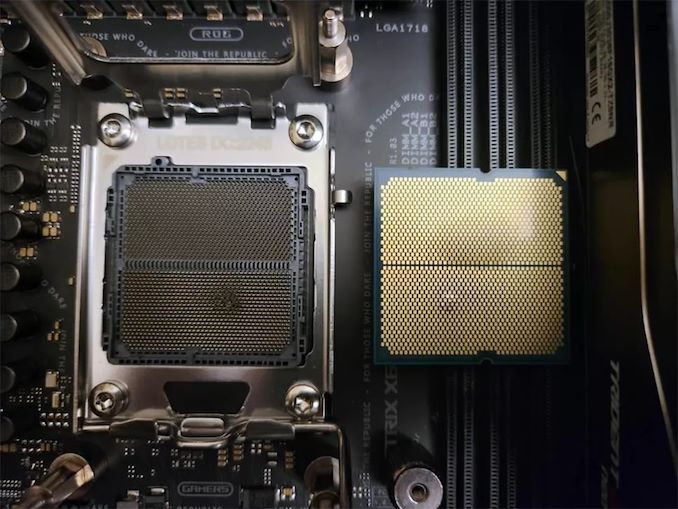AMD Issues Second Statement on Ryzen 7000 Burnout Issues: Caps SoC Voltages
by Gavin Bonshor on April 27, 2023 9:53 AM EST- Posted in
- CPUs
- AMD
- Motherboards
- Zen 4
- X3D
- Ryzen 7000
- 3D V-Cache
- AMD EXPO

Yesterday, AMD issued a statement surrounding the burnout issues some users have been experiencing with their Ryzen 7000X3D processors. The problem, reported in multiple Reddit subforums, includes some Ryzen 7000X3D CPUs burning out part of the chip, and damaging the AM5 socket in the process. This morning, AMD has released a second statement regarding the issue, including what it is doing to rectify the problem and put Ryzen 7000 processor owners at ease.
The official statement from AMD is as follows:
We expect all of our ODM partners to release new BIOS for their AM5 boards over the next few days. We recommend all users to check their motherboard manufacturers website and update their BIOS to ensure their system has the most up to date software for their processor.
Anyone whose CPU may have been impacted by this issue should contact AMD customer support. Our customer service team is aware of the situation and prioritizing these cases."
To counteract the problem, AMD has apparently identified an issue with specific chip voltages going too high when users enable AMD's EXPO memory profiles. A new cap on SoC voltages looks to be the primary change in the AGESA firmware rollout.
However, AMD's broad statement mentions that the update will address multiple power rails, which implies to some degree that the issue may be more than just the SoC power rail – or at least, that AMD isn't taking any chances. So what this entirely means is still a bit up in the air, as AMD hasn't specified in detail what it's doing outside of SoC power limits to prevent Ryzen CPUs from exceeding their specification limits.
Technically speaking, enabling EXPO memory profiles is a form of overclocking – i.e. operating the processor outside of specifications – as AMD's Ryzen 7000 family only officially supports DDR5 memory up to DDR5-5200 speeds. So going past this is putting additional stress on the memory controller in terms of clockspeeds; but the greater concern is how the various voltages on the chip are being adjusted to keep up with the demands of higher memory speeds.
One interesting point about AMD's statement is that it doesn't allude to whether or not the issue is just on its Ryzen 7000X3D processors, or whether it affects all of its Ryzen 7000 processors entirely. Regardless of the Zen 4 chip that users may have, AMD is ambiguous in its language, and it seems to be that AMD is recommended that all users with a Ryzen 7000 series processor should update to the latest firmware.
In practice, enabling EXPO memory profiles on compatible DRAM does seem to push SoC voltages beyond AMD's safe spot on the Ryzen 7000 processors, which AMD is treating as part of the cause of the burnout issue. AMD does, however, state that the changes it has made to their AGESA firmware, once flashed, shouldn't affect the user's ability to apply EXPO memory profiles on compatible kits of DDR5 memory. Which does raise the question of why motherboards were increasing SoC voltages in the first place, as presumably this shouldn't be needed if AMD's new caps won't limit EXPO memory overclocking.
In any case, AMD is actively working with its motherboard partners to release a new AGESA firmware with the new voltage limits, which they say has already been distributed. AMD claims that all AM5 motherboard vendors and models should have a new BIOS version available to them within the next few days, and is recommending all users to update their BIOS at their earliest convenience.
Image source: Speedrookie/Reddit










42 Comments
View All Comments
jerrylzy - Thursday, April 27, 2023 - link
This statement actually doesn’t say VSOC is the root cause. It’s just one of the power rails getting capped. All indications are VCore related.Gothmoth - Thursday, April 27, 2023 - link
well i do read SOC in the statement and not VCORE.... but the keyboard "experts" here sure know better. :-)Gothmoth - Thursday, April 27, 2023 - link
i guess some like to argue over semantics.jerrylzy - Thursday, April 27, 2023 - link
Layers write nuanced statements all the time. What are you even talking about? Most bulges are directly under the CCD, and keyboard experts like you think it’s the VSOC where a little over 1.3V can burn the IO die.bananaforscale - Friday, April 28, 2023 - link
Says a guy who doesn't understand that an overvoltage can cause a short, and that modern VRMs can easily push hundreds of amps through a short?jerrylzy - Sunday, April 30, 2023 - link
Do you both feel stupid now after watching Gamers Nexus’s root cause video?dqniel - Monday, May 1, 2023 - link
The GamersNexus video backs up what he said about VRMs pushing insane power into a CPU that's in a state where it should be triggering OCP rather than additional power.bananaforscale - Friday, April 28, 2023 - link
VSoC is not Vcore. Have you ever looked at a BIOS and voltage settings?jerrylzy - Sunday, April 30, 2023 - link
I don’t talk to anyone who can’t read.dqniel - Monday, May 1, 2023 - link
No, all indications are that it's vSOC related. Not vCore.